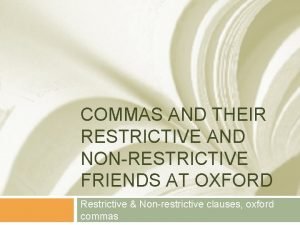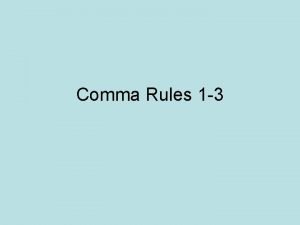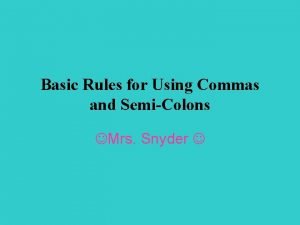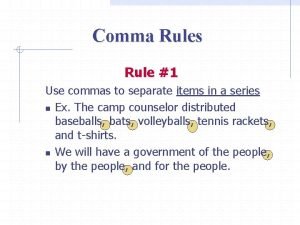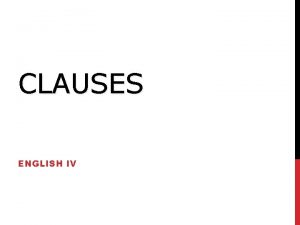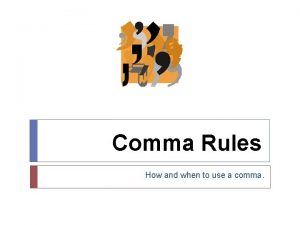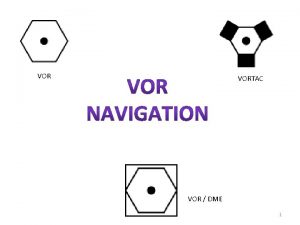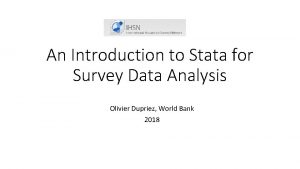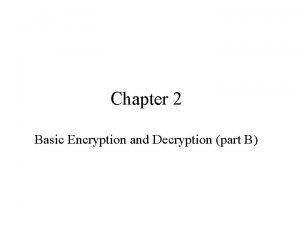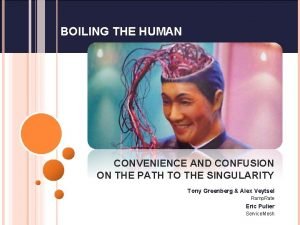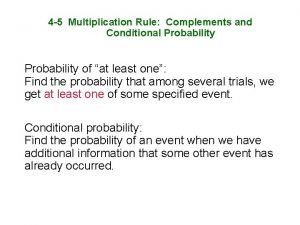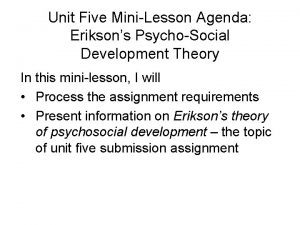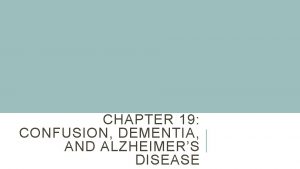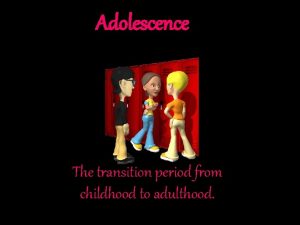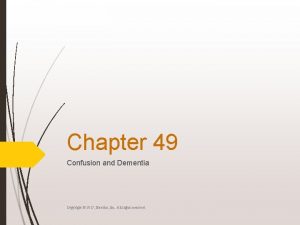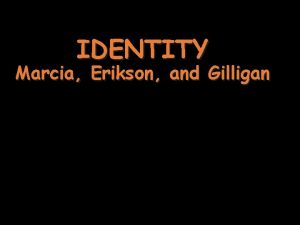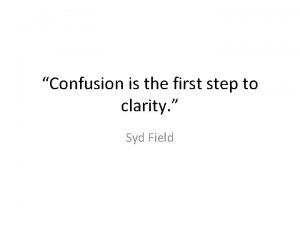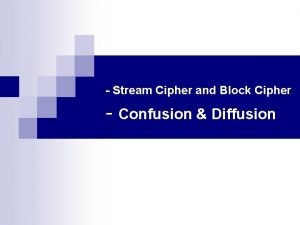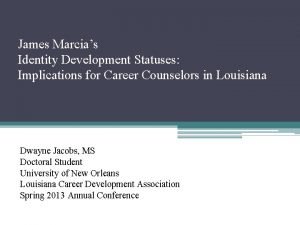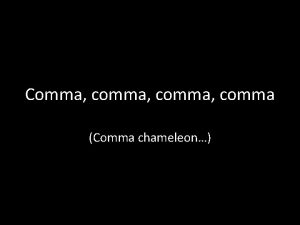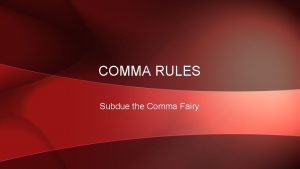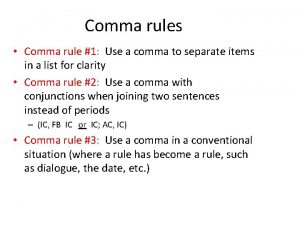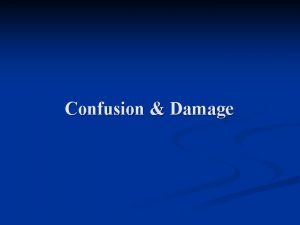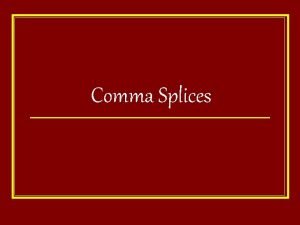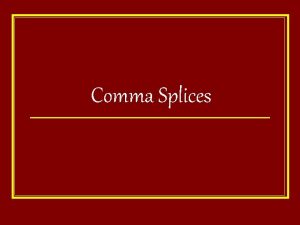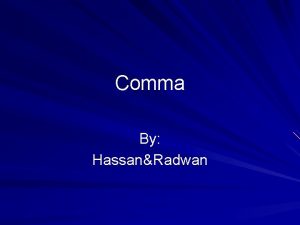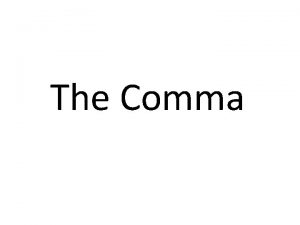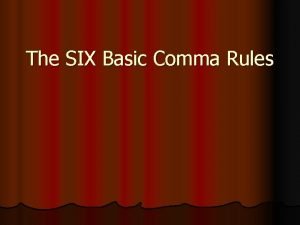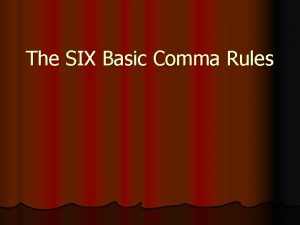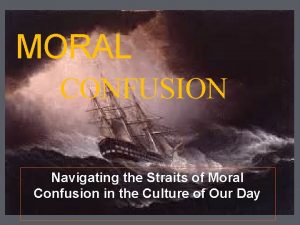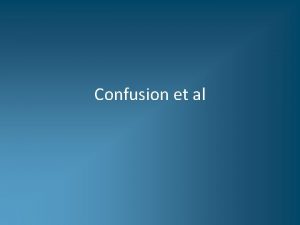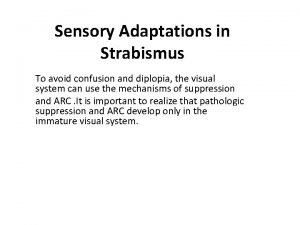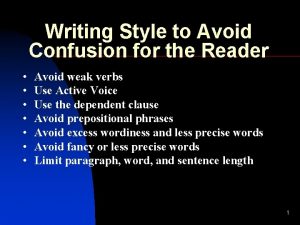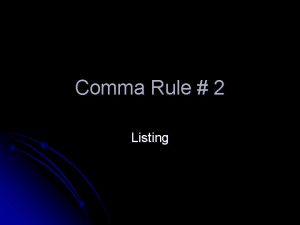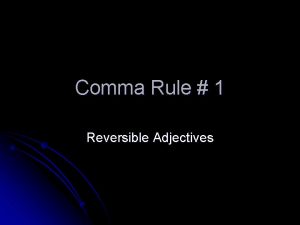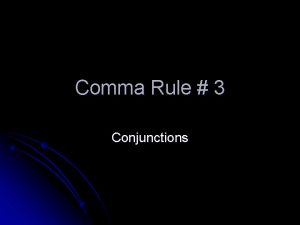Comma Rule 1 Rule 1 To avoid confusion

























![Brackets and Braces • Use brackets ( [ ] ) to signify an editor's Brackets and Braces • Use brackets ( [ ] ) to signify an editor's](https://slidetodoc.com/presentation_image_h2/83e41a3f481080f066046900fce5a155/image-26.jpg)






- Slides: 32


Comma Rule #1 • Rule 1. • To avoid confusion, use commas to separate words and word groups with a series of three or more. • Example: • My $10 million estate is to be split among my husband, daughter, son, and nephew. Omitting the comma after son would indicate that the son and nephew would have to split one-third of the estate.

Comma Rule #2 • Rule 2. • Use a comma to separate two adjectives when the word and can be inserted between them. • Examples: • He is a strong, healthy man. • We stayed at an expensive summer resort. You would not say expensive and summer resort, so no comma.

Comma Rule #3 • Rule 3. • Use a comma when an -ly adjective is used with other adjectives. • NOTE: • To test whether an -ly word is an adjective, see if it can be used alone with the noun. If it can, use the comma. • Examples: • Felix was a lonely, young boy. • I get headaches in brightly lit rooms. Brightly is not an adjective because it cannot be used alone with rooms; therefore, no comma is used between brightly and lit.

Comma Rule #4 • Rule 4. • Use commas before or surrounding the name or title of a person directly addressed. • Examples: • Will you, Alesha, do that assignment for me? • Yes, Doctor, I will. • NOTE: • Capitalize a title when directly addressing someone.

Comma Rule #5 a • Rule 5 a. • Use a comma to separate the day of the month from the year and after the year. • Example: • Kathleen met her husband on December 5, 2003, in Mill Valley, California.

Comma Rule #5 b • Rule 5 b. • If any part of the date is omitted, leave out the comma. • Example: • They met in December 2003 in Mill Valley.

Comma #6 • Rule 6. • Use a comma to separate the city from the state and after the state in a document. If you use the two-letter capitalized form of a state in a document, you do not need a comma after the state. • NOTE: With addresses on envelopes mailed via the post office, do not use any punctuation. • Example: • I lived in San Francisco, California, for 20 years. I lived in San Francisco, CA for 20 years.

Comma Rule #7 • Rule 6. • Use a comma to separate the city from the state and after the state in a document. If you use the two-letter capitalized form of a state in a document, you do not need a comma after the state. • NOTE: With addresses on envelopes mailed via the post office, do not use any punctuation. • Example: • I lived in San Francisco, California, for 20 years. I lived in San Francisco, CA for 20 years.

Comma Rule #8 • Rule 8. • Use commas to surround degrees or titles used with names. Commas are no longer required around Jr. and Sr. Commas never set off II, III, and so forth. • Example: • Al Mooney, M. D. , knew Sam Sunny Jr. and Charles Starr III.

Comma Rule #9 • Rule 9. • Use commas to set off expressions that interrupt sentence flow. • Example: • I am, as you have probably noticed, very nervous about this.

Comma Rule #10 • Rule 10. • When starting a sentence with a weak clause, use a comma after it. Conversely, do not use a comma when the sentence starts with a strong clause followed by a weak clause. • Examples: • If you are not sure about this, let me know now. • Let me know if you are not sure about this.

Comma Rule #11 • Rule 11. • Use a comma after phrases of more than three words that begin a sentence. If the phrase has fewer than three words, the comma is optional. • Examples: • To apply for this job, you must have previous experience. • On February 14 many couples give each other candy or flowers. OR • On February 14, many couples give each other candy or flowers.

Comma Rule #12 • Rule 12. • If something or someone is sufficiently identified, the description following it is considered nonessential and should be surrounded by commas. • Examples: • Freddy, who has a limp, was in an auto accident. Freddy is named, so the description is not essential. • The boy who has a limp was in an auto accident. We do not know which boy is being referred to without further description; therefore, no commas are used.

Comma Rule #13 • Rule 13. • Use a comma to separate two strong clauses joined by a coordinating conjunction--and, or, but, for, nor. You can omit the comma if the clauses are both short. • Examples: • I have painted the entire house, but he is still working on sanding the doors. • I paint and he writes.

Comma Rule #14 • Rule 14. • Use the comma to separate two sentences if it will help avoid confusion. • Example: • I chose the colors red and green, and blue was his first choice.

Comma Rule #15 • • • Rule 15. A comma splice is an error caused by joining two strong clauses with only a comma instead of separating the clauses with a conjunction, a semicolon, or a period. A run-on sentence, which is incorrect, is created by joining two strong clauses without any punctuation. Incorrect: Time flies when we are having fun, we are always having fun. (Comma splice) Time flies when we are having fun we are always having fun. (Run-on sentence) Correct: Time flies when we are having fun; we are always having fun. OR Time flies when we are having fun, and we are always having fun. (Comma is optional because both strong clauses are short. ) OR Time flies when we are having fun. We are always having fun.

Comma Rule #16 • Rule 16. • If the subject does not appear in front of the second verb, do not use a comma. • Example: • He thought quickly but still did not answer correctly.

Comma Rule #17 • Rule 17. • Use commas to introduce or interrupt direct quotations shorter than three lines. • Examples: • He actually said, "I do not care. " • "Why, " I asked, "do you always forget to do it? "

Comma Rule #18 • Rule 18. • Use a comma to separate a statement from a question. • Example: • I can go, can't I?

Comma Rule #19 • Rule 189. • Use a comma to separate contrasting parts of a sentence. • Example: • That is my money, not yours.

Comma #20 • Rule 20. • Use a comma when beginning sentences with introductory words such as well, now, or yes. • Examples: • Yes, I do need that report. • Well, I never thought I'd live to see the day. . .

Comma Rule #21 • Rule 21. • Use commas surrounding words such as therefore and however when they are used as interrupters. • • Examples: • I would, therefore, like a response. • I would be happy, however, to volunteer for the Red Cross.

Comma Rule #22 • Rule 22. • Use either a comma or a semicolon before introductory words such as namely, that is, i. e. , for example, e. g. , or for instance when they are followed by a series of items. Use a comma after the introductory word. • Examples: • You may be required to bring many items, e. g. , sleeping bags, pans, and warm clothing. OR You may be required to bring many items; e. g. , sleeping bags, pans, and warm clothing. • NOTE: • i. e. means that is; e. g. means for example

Parentheses • Understand the difference between parentheses, brackets, and braces. Use parentheses ( ( ) ) to clarify, to place an afterthought, or to add a personal comment. Be sure to include the period after the closing parenthesis. – Steve Case (AOL's former CEO) resigned from the Time-Warner board of directors in 2005. • Used for clarification. Here, commas can replace the parentheses. – You will need a flashlight for the camping trip (don't forget the batteries!). • An afterthought. Note that the period (full stop) follows the last parentheses — not before the first. Also note that replacing the parentheses with a comma may not be entirely suitable here, and is better off with a period or a semicolon. – Some believe that parentheses and commas are always interchangeable. Use your own judgment.
![Brackets and Braces Use brackets to signify an editors Brackets and Braces • Use brackets ( [ ] ) to signify an editor's](https://slidetodoc.com/presentation_image_h2/83e41a3f481080f066046900fce5a155/image-26.jpg)
Brackets and Braces • Use brackets ( [ ] ) to signify an editor's note in a regular piece of writing. You can also use brackets to clarify or to revise a direct quote so that it appeals to your own writing. Brackets are often used to encompass the word "sic" (Latin for thus), suggesting that the previous word or phrase was written "as is", with the error intended to be displayed. "[The blast] was absolutely devastating, " said Susan Smith, a local bystander at the scene of the incident. – "It was absolutely devastating!" – the actual quote by Susan Smith. • Braces ( { } ) are most widely used in denoting a numeric set in mathematics. Though generally uncommon, braces can also be used in regular writing to indicate a set of equal, independent choices. { 1, 2, 5, 10, 20 } • Choose your favorite utensil { fork, knife, spoon } and bring it to me.

There, their, they’re • Remember there, their, and they're by the following rules: – there: the word here is in there so refer to there as a word for location. – their: the word he is in their so refer to their as a word for people. – they're: there is an ' in they're so they're is like they are. Instead of saying they're, say they are to see if it makes sense. • Another hint: “there” has “here” buried inside it to remind you it refers to place, while “their” has “heir” buried in it to remind you that it has to do with possession

Phrases and Clauses • • • Phrases A PHRASE is a group of words which contains neither a subject nor a verb. (It may, however, contain a verbal form such as an infinitive, a participle, or a gerund. ) Prepositional phrases can be used as adverbs or adjectives: In a flash, she realized that the tofu had been underneath her chair all along. After midnight, Egbert's mother was on the roof dancing with a Ukrainian bullfighter. Infinitive phrases consist of an infinitive (to dance, to fly, to circumnavigate, etc. ) plus an object. They are usually used as nouns, but they can also be used as adjectives or as adverbs. As noun (subject): To see him suffer is my dearest wish. As noun (object): Cordelia longed to eat the last tamale. As adjective: Franklin had brought nothing to give his mother-in-law. As adverb: To satisfy this mysterious craving, she was willing to try almost anything.

Participial Phrases • • • Participial phrases begin with a participle. Participles are adjectives formed from verbs. They come in two tenses: present and past. present participle: an -ing word like bellowing, waltzing, singing, prancing, analyzing, fretting, sharpening, sneezing, etc. past participle: usually an -ed word like bellowed, waltzed, pranced, analyzed, believed, but sometimes an irregular form like written, sung, lost (from "to lose"), wept, frozen (from "to freeze"), Participles can be used as adjectives all by themselves: bellowing hyena flying trapeze tortured soul lost love Participial phrases consist of a participle plus an object. They are used as adjectives. The creature suffering in the dungeon was once beautiful. Surprised by the intensity of her disgust, Felicity stared at the cockroach scurrying across her omelet. Irving, screaming like a banshee, went careening from the room.

Gerund Phrases • Gerund phrases begin with a gerund (an -ing word which looks exactly like a present participle, but which is used as a noun. ) A gerund phrase can be used in any way a noun can: • As subject: Playing Old Maid has been her downfall. • As direct object: He loves embarrassing his sisters. • As subjective complement: One of his milder vices is playing video games until dawn. • As object of preposition: She amused herself with bungee-jumping from helicopters.

Clauses • • A clause is a group of words containing at least a subject and a verb (the baby ate), and frequently it lets its hair down by containing some kind of a complement as well (the baby ate the goldfish). There are two kinds of clauses: independent and dependent. Like John Wayne, an independent clause can stand alone. I shall haunt you till your dying day. It may, however, become part of a larger sentence if it is connected to other clauses and phrases by a semicolon or by a coordinating conjunction. I shall haunt you till your dying day; I shall haunt your friends and relatives after that. I shall haunt you till your dying day, and I shall haunt your friends and relatives after that. If you try to join two independent clauses with a comma, grammatical purists among your readers will regard you with horror as the perpetrator of a comma splice. While it's true that other crises, such as global warming, are more important than this, have pity on the purists. Use a semicolon or a coordinating conjunction to join two independent clauses.

Coordinating Conjunctions • The coordinating conjunctions that join independent clauses include and, but, or, neither, yet, for, and so. The coordinating conjunction does not belong in either clause, but merely joins them together. Put a comma before the coordinating conjunction (but note that this particular punctuation rule is so commonly ignored -- particularly in short sentences -- that it is in danger of disappearing). • He checked his i. Phone, and he reviewed his email. • Fanny Dooley likes sunbathing, but she loves swimming more. • She had lost her castanets, so she used her Grandpa Henry’s dentures. • The cat had broken their Ming vase, yet the cat did not seem to care.
 Comma comma comma chameleon meme
Comma comma comma chameleon meme What type of plan shows the layout of the hvac system
What type of plan shows the layout of the hvac system Interrupter examples
Interrupter examples Examples of swabi
Examples of swabi Comma before however
Comma before however Comma rule 4
Comma rule 4 Comma rule 17e
Comma rule 17e Comma before so
Comma before so Constellation confusion worksheet
Constellation confusion worksheet Vor/dme symbol
Vor/dme symbol Confusion matrix stata
Confusion matrix stata Confusión de numeros
Confusión de numeros Confusion vs diffusion
Confusion vs diffusion When confusion's my companion
When confusion's my companion Melting confusion pmv
Melting confusion pmv Confusion of the inverse occurs when we incorrectly believe
Confusion of the inverse occurs when we incorrectly believe Confusion and diffusion
Confusion and diffusion Acute confusion related to
Acute confusion related to School age erikson
School age erikson Autonomy vs shame and doubt maladaptation
Autonomy vs shame and doubt maladaptation Identity vs confusion
Identity vs confusion Chapter 19 confusion dementia and alzheimer's disease
Chapter 19 confusion dementia and alzheimer's disease Identity vs confusion
Identity vs confusion Nbsvm
Nbsvm If a resident with ad shows violent behavior the na should
If a resident with ad shows violent behavior the na should Chapter 49 confusion and dementia
Chapter 49 confusion and dementia Identity foreclosure
Identity foreclosure Dotson
Dotson Confusion and diffusion in cryptography
Confusion and diffusion in cryptography Alice in! 1 – the rabbit hole of confusion
Alice in! 1 – the rabbit hole of confusion Test chapter 10 geriatric care
Test chapter 10 geriatric care What is identity vs role confusion
What is identity vs role confusion Epilepsy
Epilepsy
